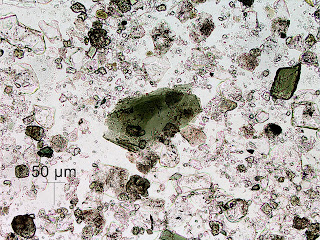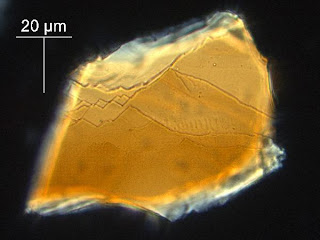Identification of siliciclastics within a smear slide sounds tricky, but really as a first pass you are looking for the relative abundances of the common rock-forming minerals, plus or minus a few, given diagenetic processes of lake systems. In thin sections, the hard rock equivalent of a smear slide, mineral identification requires a thirty micron thick slice of polished rock (that's about one-third of the thickness of a sheet of printer paper). For smear slides, we are removing this variable, but still looking for some of the same optical clues. The first step to identify the siliciclastic material in a smear slide is to learn which components to rule out.
Working with the polarizers crossed, rotate the stage back and forth at least ninety degrees. The components that flash as you do this are ordered crystalline structures with characteristic optical properties, or minerals.
There will be some components that are biogenically produced minerals. When making a first pass over a slide, and I see something that I do not recognize, I ask myself, “Is this biogenic or not?”. Broken diatoms, sponge spicules, ostracode shell fragments, and fecal pellets are easy to misidentify as minerals sometimes. They usually catch my eye quickly, as they can be large relative to other smear slide components and are highly-ordered structures. The shell fragments and pellets will light up when you flip the polarizer, but they are carbonates, so you can rule them out based on their extreme birefringence, an optical property that makes this mineral go from transparent in plane-polarized light to a surprising array of bright pastel colors under cross polarized light. And for this matter, learn to see through the non-biogenic carbonates as well. There are no siliciclastics that exhibit extreme birefringence.
When you flip back to plane polarized light, you many notice that some components did not appear in cross-polarized light. These components (mostly sponge spicules, diatoms, and volcanic glass) are made of cryptocrystalline silica, meaning the lack crystal structure, thus they have no optical properties. In other words, when you cross the polarizers, they will disappear.
Once you've ruled out these components, there's a good chance that the majority of the siliciclastics that you see are either quartz or some type of feldspar (if you have any siliciclastics, terrestrial material – it is possible to not see any at all depending on what sort of depositional environment you have). Both can vary in shape and size, are mostly transparent in plane polarized light, have regular extinction angles in cross polarized light, have moderate to high relief, and can be worn down in transit from an outcrop somewhere to the bottom of a lake. However, if you see a straight side, or two straight sides that come together at a ninety degree angle, you are most likely looking at a feldspar. If you see a broken edge that is conical and smooth (like a chip in glass or on the edge of an arrowhead), you are seeing quartz's conchoidal fracture.
 |
| quartz: conchoidal fracture, high relief |
 |
| feldspar: clear, 90/90 cleavage pattern, relief |
Another clear, transparent mineral is muscovite. Most commonly you will see muscovite as shredded, birefringent streaks. Less commonly, you may see faint thin, flat (flaky) minerals that exhibit extinction under cross polarized light and always with the lowest relief, which would also be muscovite.
You may see colored, transparent minerals in plane polarized light as well. The first step is to look at relief of the mineral. Relief can be hard to recognize as shape and thickness are not controlled for sediments in smear slides, but I like to think of it as the boldness of the outline for a single grain – the bolder the line, the more relief the mineral has.
There are two common colored, transparent micas – chlorite and biotite. Generally, chlorite is more often green and sometimes blue, but biotite can appear brown at one angle and green at another in plane polarized light (this characteristic is called pleochroism). If the extinction looks bumpy, you are surely looking at biotite (this is called bird’s eye extinction). Chlorite has a variable chemical composition that can sometimes lead to anomalous birefringence colors under crossed polarized light – ranging from a curious brown to bright purple. Biotite's extinction is, more often than not, pseudoisotropic. This is because the flakes settle on the slide such that the analyst will be looking down the c-axis of a very thin, but strongly colored mineral. To my eye, the extinction is a faint dark green that is easier to see if you turn the brightness way up before you rotate the stage (remember to turn it back down before you flip back to plane polarized light so that you don’t blind yourself!).
 |
| chlorite: color, low relief |
 |
| biotite: color, low relief, texture |
If the colored transparent mineral has high relief, it is likely an amphibole or a pyroxene. You may be able to see cracks along the surface of the mineral. Are they in a regular pattern (Follow the cracks down the plane of focus as you move the stage up and down – this can help a bit.)? This is called cleavage, or the way certain minerals break based on their crystal structure. This is most often used to assess whether you are looking at a pyroxene (90/90) or an amphibole (60/120).
 |
| pyroxene: 90/90 cleavage pattern |
 |
| amphibole: 60/120 cleavage pattern |
Now for a few oddballs that are common enough to note, but rarely dominate a slide:
If the colored transparent mineral is green-to-gray, of moderate relief, nonpleochroic, and shows conchoidal fracture, it is olivine.
 |
| olivine: green, high relief, conchoidal fracture |
If the mineral is euhedral or semi-euhedral with elongate prisms and moderate to high relief, it is likely included in group of minerals called heavy minerals. These are less easy to come by in thin section, but are very useful for dating events given how resistent they are to weathering, and are not uncommon in smear slides given their densities. Distinguishing the minerals within this group of silicates can be tricky, but there are subtle differences that give away which is which. There are at least three to note: zircon, tourmaline, and apatite. All three commonly have inclusions and refract light in plane polarized light (you will notice this quickly – the light refracts as a shiny spectrum of colors that follow the outline of the grain). Zircon can appear slightly pink in plane polarized light and is nonpleochroic. Tourmaline can be just about any color, is often pleochroic, and is moderately birefringent. Apatite has low birefringence.
 |
| zircon: high relief, pinkish/iridescent in plane light |
 |
| tourmaline: euhedral, many colors |
 |
| apatite: euhedral, medium relief |
No comments:
Post a Comment